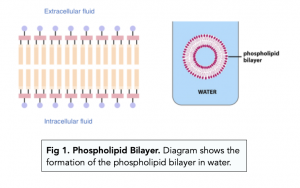Phospholipid Bilayer (A-level Biology)
Phospholipid Bilayer
Function of Phospholipids
The properties of phospholipids allow them to be a vital component of cell membranes.
- Phospholipids are found in cell membranes. Phospholipids are the core component of most cell membranes of most organisms. Because cell membranes are the organelle which give structure to a cell, as well as control what goes in and out of cells, it can be argued that phospholipids are one of the most important biological molecules.
- Cell membranes are present in both prokaryotic and eukaryotic organisms. While eukaryotes lack a cell wall, both prokaryotic and eukaryotic organisms have a plasma membrane that acts as the cell’s gatekeeper. This means that phospholipids are necessary molecules that must be present in both prokaryote and eukaryotes so that they may have a functioning cell membrane.
- Their amphipathic property is crucial. Remember, the fatty acid chains are hydrophobic tails and the phosphate group, along with the glycerol component, make up the hydrophilic heads.
- The hydrophilic heads point outwards in cell membranes. How do phospholipids form cell membranes? When phospholipids are added to water, their hydrophilic heads face outwards, and their hydrophobic tails face inwards, forming a near circular barrier that has an internal space. This occurs spontaneously.
- A phospholipid bilayer is formed. The barrier formed is known as the phospholipid bilayer, which is another name for a cell membrane. The middle of the barrier is hydrophobic, so aqueous (water-soluble) molecules cannot simply diffuse through (like they can through the cell wall) – they need to move via an ion channel.

A phospholipid bilayer is a thin layer of phospholipid molecules that acts as a barrier to separate the inside of a cell from its outside environment. It is an essential component of cell membranes and helps to maintain the integrity and stability of cells.
Phospholipids are a type of lipid molecule that consist of a polar, hydrophilic head and two hydrophobic, non-polar tails. These unique properties allow phospholipids to spontaneously self-assemble into a double layer, or bilayer, when placed in an aqueous environment.
The structure of a phospholipid bilayer is composed of two layers of phospholipid molecules with their hydrophobic tails facing each other and their hydrophilic heads facing outward. The hydrophobic tails form a hydrophobic interior, while the hydrophilic heads interact with the surrounding water-based environment.
The phospholipid bilayer plays a crucial role in maintaining the integrity and stability of cells. It acts as a semi-permeable barrier, allowing small, hydrophobic molecules to pass through while excluding larger, hydrophilic molecules. This allows cells to regulate what enters and exits the cell and helps to maintain the proper balance of ions and other substances within the cell.
In addition to the phospholipid bilayer, cell membranes also contain other important components such as proteins and cholesterol. Proteins play various roles, such as acting as channels for the movement of ions and other molecules across the membrane, and providing structural support to the bilayer. Cholesterol helps to regulate the fluidity of the membrane and maintain its stability.
Yes, substances can cross the phospholipid bilayer, but they must be small enough to diffuse through the hydrophobic interior of the bilayer or be transported by membrane proteins. Large, hydrophilic molecules cannot diffuse through the bilayer on their own and must be actively transported across the membrane.
The phospholipid bilayer is an important structure in biology because it plays a crucial role in maintaining the integrity and stability of cells. It acts as a semi-permeable barrier, allowing cells to regulate what enters and exits, and helps to maintain the proper balance of ions and other substances within the cell. This is essential for the survival and proper functioning of cells and is a fundamental concept in the study of biology.





Still got a question? Leave a comment
Leave a comment